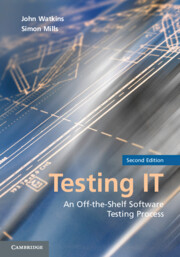Book contents
- Frontmatter
- Contents
- Foreword to the Second Edition by Geoff Thompson
- Foreword to the First Edition by Maurice Rosenburgh
- Acknowledgments
- 1 Introduction
- PART 1 THE TRADITIONAL TESTING PROCESS
- PART 2 THE TESTING PROCESS IN THE REAL WORLD: ILLUSTRATIVE CASE STUDIES
- PART 3 THE APPENDICES
- References
- Glossary
- Index
1 - Introduction
Published online by Cambridge University Press: 03 May 2011
- Frontmatter
- Contents
- Foreword to the Second Edition by Geoff Thompson
- Foreword to the First Edition by Maurice Rosenburgh
- Acknowledgments
- 1 Introduction
- PART 1 THE TRADITIONAL TESTING PROCESS
- PART 2 THE TESTING PROCESS IN THE REAL WORLD: ILLUSTRATIVE CASE STUDIES
- PART 3 THE APPENDICES
- References
- Glossary
- Index
Summary
“Hmm, The Wheel you say! Well, I don't wish to belittle your achievement, but I've travelled far and wide and I've seen a great many of these things invented by a great many people in a great many different caves!”
– Big Ugg, Neander Valley, 35,000 b.c.Purpose of the Book
This book provides comprehensive and rigorous guidance to workers in the field of software testing for researching or setting up a software testing process within organizations.
The book provides advice and guidance on all aspects of the testing process, including:
The need to test software and the approach to testing
Specific details of testing techniques, with examples
The planning and management of testing projects
Testing roles and responsibilities
Comprehensive details of the testing phases
Extensive testing document templates, proformas, and checklists
Recommendations for testing process improvement and the role and use of metrics
The testing challenges facing testers involved in quality assurance tasks on agile projects
The testing challenges facing developers of object-oriented and component-based systems
The book covers the testing of software from a number of sources, including software developed or modified in-house, software that represents the modification or extension of existing legacy software systems, and software developed on behalf of an organization by a third party.
The book also covers acceptance testing of commercial off-the-shelf (COTS) software procured by an organization, or COTS software that has undergone bespoke development either internally or by a third party on behalf of an organization.
- Type
- Chapter
- Information
- Testing ITAn Off-the-Shelf Software Testing Process, pp. 1 - 6Publisher: Cambridge University PressPrint publication year: 2010

